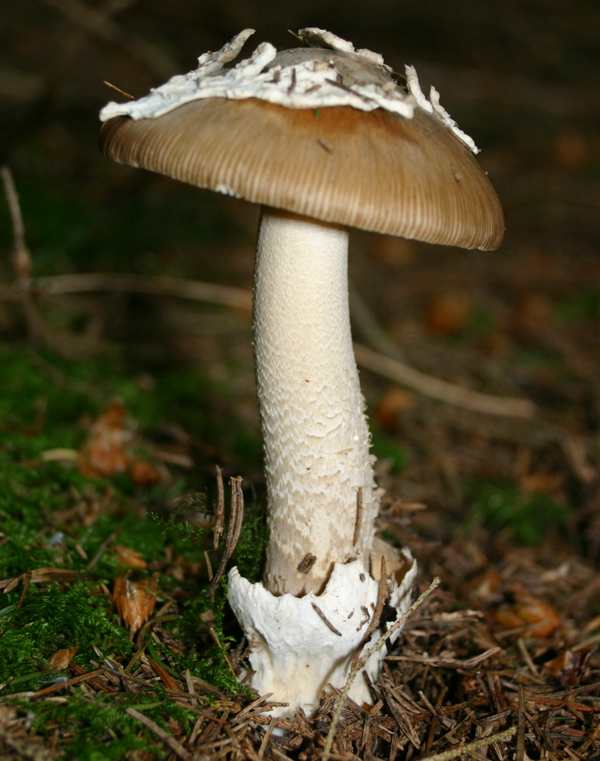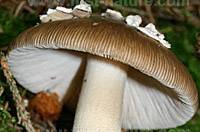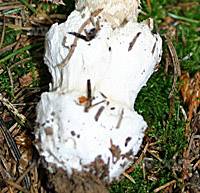Amanita submembranacea (Bon) Gröger - Olive Amanita
Phylum: Basidiomycota - Class: Agaricomycetes - Order: Agaricales - Family: Amanitaceae
Distribution - Taxonomic History - Etymology - Identification - Culinary Notes - Reference Sources

Similar to Amanita ceciliae but usually retaining a volva, this smallish and generally fairly dark grisette occurs in association with fir, birch, larch and spruce. Amanita submembranacea was originally described from France and is now known to occur in most European countries, from Norway right down to the Mediterranean and including the Iberian Peninsula. Its synonyms include Amanitopsis submembranacea.
Distribution
Amanita submembranacea is an infrequent to rare find in Britain and Ireland, and it is also rather uncommon in mainland Europe, most often being found in acidic areas.
Taxonomic history
In 1975 the well-known French mycologist Marcel Bon (born 1925) described this species, naming it Amanitopsis submembranacea; and four years later Frieder Gröger, a German mycologist, defined it as Amanita submembranacea, the current name by which this species is listed in the British Mycological Society checklist of fungi. Some people refer to this mushroom as the Peeling Paint Ringless Amanita.
Etymology
The specific epithet submembranacea is simply a reference to the very thin (submembranous) and brittle or leathery bag-like volva at the base of the stem.
For a detailed description of the Amanita genus and identification of species see our Simple Amanita Key...
Identification guide
 |
CapIn young specimens the cap margin is noticeably paler than the rest of the cap, but this feature is not always retained as the caps expand fully. Olivaceous brown; the margin marked with strong radial lines; sometimes with irregular grey veil fragments mainly in centre; convex, eventually flattening; 6 to 10cm across. GillsCreamy white, turning grey or brownish with age; free, with many short gills unevenly distributed; only moderately crowded. |
 |
StemPale grey, with scales in a regular zig-zag pattern; no ring; 8 to 15cm long, 1 to 2cm diameter; slightly swollen stem base. VolvaThe most obvious distinguishing feature of Amanita submembranacea is its thin, leathery (submembranous) white bag-like volva that greys and hardens, its surface looking like flakes of dull grey paint on a canvas background. |
SporesRoughly spherical, 10-14μm in diameter. Spore printWhite. |
|
Odour/taste |
Not distinctive. |
Habitat & Ecological role |
Ectomycorrhizal, usually found in coniferous forests mainly with firs, larches and spruces, but also occasionally under birches. |
Season |
July to October in Britain. |
Similar species |
Amanita virosa is similar but has a smooth stem without a snakeskin pattern. Amanita ceciliae has an olivaceous fawn cap with a pale margin; its volva is substantial rather than thin and leathery. |
Culinary Notes
This is a very uncommon to rare species, and although many ringless Amanita species are known to be edible there is no certainty that Amanita submembranacea is edible; it should therefore be treated as 'suspect' and not eaten.
Reference Sources
Fascinated by Fungi, 2nd Edition, Pat O'Reilly 2016, reprinted by Coch-y-bonddu Books in 2022.
BMS List of English Names for Fungi
Geoffrey Kibby, (2012) Genus Amanita in Great Britain, self-published monograph.
Funga Nordica: 2nd edition 2012. Edited by Knudsen, H. & Vesterholt, J. ISBN 9788798396130
Paul M. Kirk, Paul F. Cannon, David W. Minter and J. A. Stalpers (2008). Dictionary of the Fungi; CABI
Taxonomic history and synonym information on these pages is drawn from many sources but in particular from the British Mycological Society's GB Checklist of Fungi.

